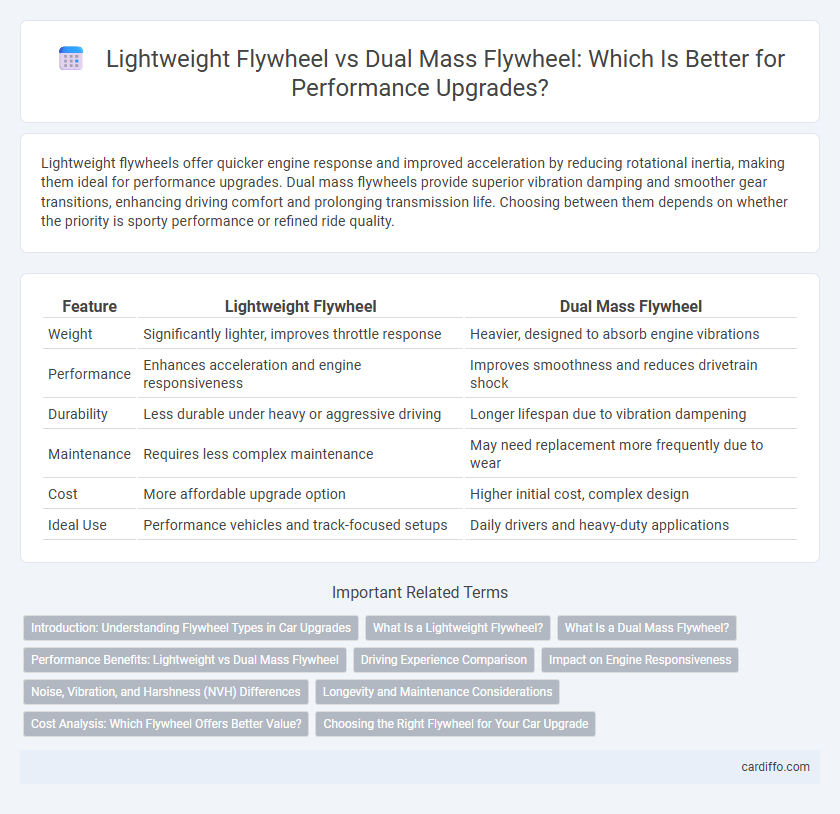Lightweight flywheels offer quicker engine response and improved acceleration by reducing rotational inertia, making them ideal for performance upgrades. Dual mass flywheels provide superior vibration damping and smoother gear transitions, enhancing driving comfort and prolonging transmission life. Choosing between them depends on whether the priority is sporty performance or refined ride quality.
Table of Comparison
| Feature | Lightweight Flywheel | Dual Mass Flywheel |
|---|---|---|
| Weight | Significantly lighter, improves throttle response | Heavier, designed to absorb engine vibrations |
| Performance | Enhances acceleration and engine responsiveness | Improves smoothness and reduces drivetrain shock |
| Durability | Less durable under heavy or aggressive driving | Longer lifespan due to vibration dampening |
| Maintenance | Requires less complex maintenance | May need replacement more frequently due to wear |
| Cost | More affordable upgrade option | Higher initial cost, complex design |
| Ideal Use | Performance vehicles and track-focused setups | Daily drivers and heavy-duty applications |
Introduction: Understanding Flywheel Types in Car Upgrades
Lightweight flywheels reduce rotational mass, enabling faster engine revving and improved throttle response in performance car upgrades. Dual mass flywheels (DMF) are designed to absorb vibrations and smooth out power delivery, enhancing driving comfort in everyday use. Choosing between lightweight and dual mass flywheels depends on balancing performance gains with noise reduction and drivetrain durability.
What Is a Lightweight Flywheel?
A lightweight flywheel is an upgraded component designed to reduce rotational mass in a vehicle's engine, enhancing throttle response and acceleration. Compared to a dual mass flywheel, it offers quicker engine revving by decreasing inertia, which improves overall driving dynamics and performance. This upgrade is popular in motorsports and performance tuning for achieving more immediate power delivery.
What Is a Dual Mass Flywheel?
A dual mass flywheel (DMF) is an advanced automotive component designed to reduce vibration and improve engine smoothness by using two separate flywheels connected by a series of springs. It absorbs torsional vibrations generated during engine operation, enhancing driving comfort and protecting the drivetrain from excessive wear. Compared to lightweight flywheels, DMFs offer superior noise and vibration damping, making them ideal for modern vehicles with complex powertrains.
Performance Benefits: Lightweight vs Dual Mass Flywheel
Lightweight flywheels improve engine responsiveness and acceleration by reducing rotational mass, enabling quicker rev shifts and enhanced throttle control. Dual mass flywheels excel in vibration dampening and smoother power delivery, prolonging transmission life in vehicles with high torque. Choosing a lightweight flywheel maximizes performance gains, while dual mass flywheels prioritize durability and driving comfort in demanding conditions.
Driving Experience Comparison
A lightweight flywheel significantly improves throttle response and engine acceleration by reducing rotational mass, resulting in a more engaging and spirited driving experience. In contrast, a dual mass flywheel prioritizes smoothness and vibration dampening, offering a quieter and more refined ride at the expense of some responsiveness. Drivers seeking enhanced control and quicker gear shifts favor lightweight flywheels, while those valuing comfort and noise reduction opt for dual mass flywheels.
Impact on Engine Responsiveness
Lightweight flywheels reduce rotational inertia, enhancing engine responsiveness by allowing quicker throttle changes and faster acceleration. Dual mass flywheels, while effective in dampening vibrations, introduce additional rotational mass that can slightly delay throttle response. Choosing a lightweight flywheel upgrade improves engine agility and performance, especially in high-revving or performance-oriented vehicles.
Noise, Vibration, and Harshness (NVH) Differences
Lightweight flywheels generate higher noise and vibration levels compared to dual mass flywheels due to their rigid structure and reduced damping capability. Dual mass flywheels excel in minimizing Noise, Vibration, and Harshness (NVH) by absorbing torsional vibrations through their dual-mass design, enhancing driving comfort. NVH reduction in dual mass flywheels reduces drivetrain wear and improves overall vehicle refinement.
Longevity and Maintenance Considerations
Lightweight flywheels offer increased engine responsiveness but may require more frequent maintenance due to reduced damping capabilities, potentially impacting longevity. Dual mass flywheels provide superior vibration absorption, enhancing drivetrain longevity and reducing wear on transmission components. Maintenance intervals for dual mass flywheels tend to be longer, making them a preferred choice for durability in high-mileage vehicles.
Cost Analysis: Which Flywheel Offers Better Value?
Lightweight flywheels typically cost more upfront but offer improved engine responsiveness and fuel efficiency, which can lead to long-term savings. Dual mass flywheels are generally less expensive initially and provide smoother operation and reduced drivetrain wear, lowering maintenance costs over time. Comparing total ownership cost, lightweight flywheels deliver better value for performance-focused drivers, while dual mass flywheels suit those prioritizing comfort and budget-friendly maintenance.
Choosing the Right Flywheel for Your Car Upgrade
Choosing the right flywheel for your car upgrade depends on your driving style and performance goals. Lightweight flywheels offer faster engine response and improved acceleration by reducing rotational mass, making them ideal for spirited driving and track use. Dual mass flywheels provide smoother operation and better vibration dampening, enhancing comfort and drivability for daily commuting and long trips.
Lightweight Flywheel vs Dual Mass Flywheel Infographic

 cardiffo.com
cardiffo.com